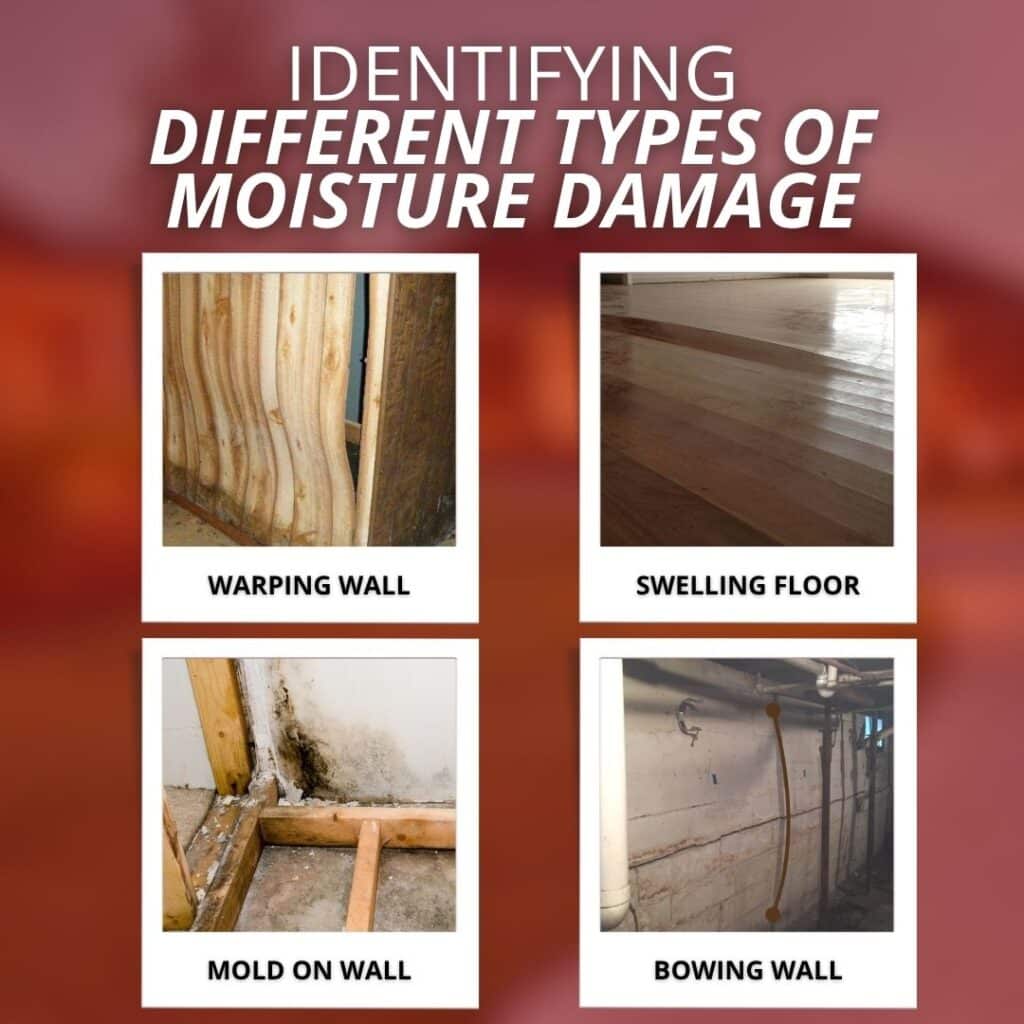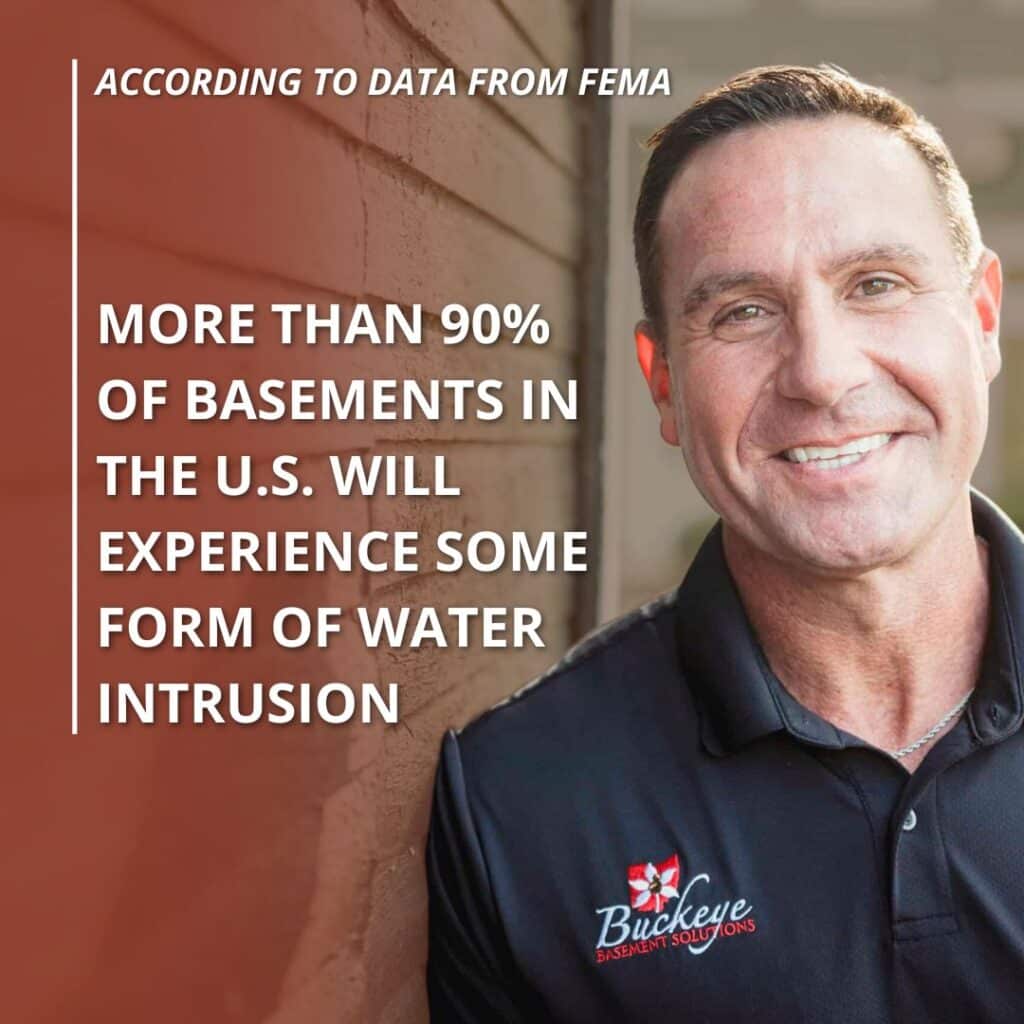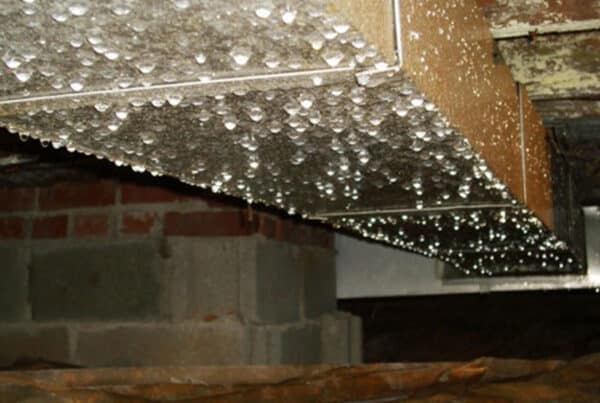When you notice your basement walls, floors, or wood trim starting to look uneven or bent, it’s easy to assume it’s just cosmetic wear. In reality, visible warping or swelling can signal much deeper issues within your home. For many Ohio homeowners, these early signs often point to excess moisture, poor drainage, or developing foundation problems.
In Columbus and surrounding areas, moisture control is one of the biggest challenges for basements and crawl spaces. Seasonal humidity, freeze-thaw cycles, and heavy rainfall can all affect how your home’s foundation and materials respond to stress.
Understanding the difference between warping and swelling, and what each one says about your home, is the first step toward protecting your foundation and avoiding expensive repairs.
Warping vs Swelling: What’s the Difference?
Warping and swelling can look similar, but they have very different causes and implications.
- Warping refers to a material bending or twisting out of its original shape. It usually happens when there is uneven pressure or a temperature change. For example, a wooden beam might warp if one side stays damp while the other side stays dry.
- Swelling means the material expands as it absorbs moisture. It can make drywall bubble, floorboards rise, cement floors crack, or basement walls push outward.
Both problems start small and worsen over time. They often occur together, especially in basements or crawl spaces with high humidity or water intrusion.
Buckeye Basement Solutions sees these warning signs often during inspections. What starts as a minor distortion can develop into full structural movement if not treated promptly.

How Moisture Leads to Warping and Swelling
Moisture is the most common trigger for both warping and swelling. When materials like wood, drywall, or concrete absorb water, they expand. Once that moisture dries, the material shrinks unevenly, which leads to distortion.
In Ohio, basements are especially vulnerable because the region experiences both heavy rainfall and fluctuating temperatures. Over time, this repeated expansion and contraction weakens the materials supporting your foundation.
Common sources of basement moisture include:
- Poor drainage around the home’s exterior
- Cracks in foundation walls or floors
- Failing sump pumps or improper discharge lines
- Leaky plumbing or condensation on pipes
- Missing or clogged gutters and downspouts
The EPA notes that maintaining indoor humidity below 60% can help prevent mold, warping, and other moisture-related damage in homes.
Consistent control is essential because once materials absorb water, they rarely return to their original shape.
Signs of Warping in the Basement
Warping usually shows up in materials that have dried unevenly or have been under pressure for long periods. Watch for these warning signs:
- Bent or Curved Wooden Beams: Support joists that look bowed, cupped, or twisted indicate long-term exposure to moisture or uneven load distribution.
- Uneven or Raised Flooring: If laminate or hardwood near the basement or lower level seems uneven, the subfloor beneath it might be warping.
- Gaps Between Trim and Walls: Separation between baseboards and the wall often happens when moisture causes the wall framing to twist or shift.
- Cracked Drywall or Ceiling Lines: These cracks may not always be from settling. Warped studs or joists can create pressure points that cause drywall seams to open.
- Doors or Windows That Stick: A common symptom of structural warping is when frames shift slightly out of alignment.
Warping affects the structure’s stability. If ignored, it can create uneven floors, misaligned walls, and eventually lead to foundation movement.
Signs of Swelling in the Basement
Swelling is a sign that your home is actively absorbing moisture. Unlike warping, which is usually a long-term response, swelling happens quickly after water exposure.
You might notice:
- Walls that Feel Soft or Spongy: Moist drywall or plaster can absorb water and begin to bubble or discolor.
- Baseboards Pulling Away from the Wall: As materials swell, nails or adhesives loosen.
- Musty Odors or Visible Mold Growth: These often appear within days of moisture buildup.
- Doors That No Longer Close Properly: When frames swell, they expand beyond their original dimensions.
- Visible Water Stains or Ripples on Wood Surfaces: This suggests active water intrusion nearby.
Swelling materials can create pressure that transfers to the foundation or nearby structural supports. It’s a warning that the basement is too damp and needs immediate attention.
How Both Affect Your Foundation
Moisture doesn’t just damage surfaces. Over time, it can compromise the structural integrity of your foundation. Here’s how:
- Uneven Pressure on Foundation Walls: When wood beams warp or concrete swells, it puts uneven force on connected surfaces. That stress can cause cracks or wall movement.
- Expansion of Clay Soils: Columbus soil is rich in clay, which expands when wet and shrinks when dry. These cycles create pressure against basement walls, leading to bowing, bulging, or cracking.
- Weakened Support Structures: Persistent moisture can rot or corrode the materials that hold up your home. In crawl spaces, this may lead to sagging floors or shifting piers.
- Compromised Waterproofing Systems: When materials swell, they can pull away from sealants or barriers, allowing more water to enter.
The longer the issue continues, the harder and more expensive it becomes to fix. Regular foundation inspections and moisture control keep small problems from growing into major repairs.

Reading the Signs of Warping or Swelling
| What You See | Likely Cause | Possible Foundation Impact |
| Curved or bowed wooden beams | Long-term moisture exposure | Uneven pressure on support joists |
| Soft or bubbling drywall | Active water intrusion | Moisture transfer to framing |
| Separated baseboards | Swelling or expansion behind walls | Wall displacement or cracking |
| Sticky doors and windows | Warped frames or structural shifting | Settlement or misalignment |
| White powder on basement walls (efflorescence) | Water movement through concrete | Indicates seepage and potential cracking |
This quick reference helps homeowners recognize which visible clues might suggest more serious foundation problems. Addressing the root cause early prevents bigger structural issues later.
How Does Basement Waterproofing Help?
Basement waterproofing is one of the best ways to prevent both warping and swelling. It helps manage moisture before it reaches the materials inside your home.
Buckeye Basement Solutions uses several methods to achieve long-term protection:
- Interior Drainage Systems: Collect and redirect water that seeps through basement walls or floors.
- Sump Pump and Pit Systems: Actively remove groundwater from the lowest areas before it builds up.
- Exterior Waterproofing Membranes: Block water from entering foundation walls from the outside.
- Vapor Barriers for Crawl Spaces: Seal exposed soil to stop moisture from rising into living areas.
- Dehumidifier Systems: Maintain safe humidity levels year-round.
Together, these solutions create a dry, stable environment that keeps materials from expanding or warping.
According to FEMA, more than 90% of basements in the United States will experience some form of water intrusion during their lifespan.
That makes preventive waterproofing one of the most valuable long-term investments a homeowner can make.
Foundation Repair That Addresses the Damage
If warping or swelling has already caused visible foundation damage, professional repair is the next step. Buckeye Basement Solutions specializes in techniques that restore strength and stability to damaged walls and floors.
Common solutions include:
- Carbon Fiber Reinforcement: Adds support to bowing walls without major excavation.
- Steel I-Beams or Wall Anchors: Counteract external soil pressure and straighten structural movement.
- Structural Carpentry Repairs: Replace damaged beams, joists, or subfloors affected by warping.
- Masonry and Concrete Repair: Fill cracks and restore stability to weakened foundations.
Foundation repair is often paired with waterproofing to ensure the problem does not return. Fixing the cause and the symptom together is the best long-term approach.
When to Call a Professional
You should contact a foundation and basement specialist if you notice:
- Persistent dampness or musty smells in your basement
- Cracks forming along walls or floors
- Soft, swollen, or bowed wooden beams
- Water pooling near the foundation after rain
- Doors or windows that suddenly stick or shift
Buckeye Basement Solutions provides complete evaluations to identify the cause of foundation stress and the best way to fix it.
Our team handles everything from inspections and waterproofing to structural repair, so you don’t have to coordinate multiple contractors.
What to Expect During an Inspection
During an inspection, technicians evaluate both the visible and hidden signs of damage. Buckeye Basement Solutions starts by identifying the source of moisture and then checks how it has affected nearby materials.
Typical steps include:
- Examining walls, floors, and framing for distortion or movement
- Measuring moisture levels with specialized sensors
- Checking for cracks, efflorescence, or staining on concrete
- Assessing sump pump operation and drainage systems
- Reviewing humidity control and ventilation
By finding the source early, your home can often be repaired with minimal disruption. Waiting too long allows the damage to spread, creating higher costs and longer repair timelines.
Preventing Future Warping and Swelling
Once repairs are made, prevention should be part of your ongoing home maintenance. Columbus homeowners can protect their foundation with a few simple habits:
- Monitor Basement Humidity: Keep humidity between 30 and 50% using a dehumidifier.
- Maintain Gutters and Downspouts: Ensure water drains at least 6 feet away from your foundation.
- Inspect Sump Pumps Twice a Year: Test the float switch and backup battery before heavy rain seasons.
- Seal Cracks Early: Even small foundation cracks can let in moisture over time.
- Schedule Routine Foundation Inspections: Annual or biannual checks catch problems early.
Moisture control isn’t just about comfort. It directly impacts your home’s safety, stability, and value.
Other Related Foundation Questions
Why does my basement wall curve inward?
This usually happens when soil expands from excess moisture and pushes against the foundation. If left untreated, it can lead to cracks or collapse.
What if only one section of my basement shows damage?
Localized issues can still signal widespread problems. A professional should inspect the entire foundation to rule out hidden stress points.
Will waterproofing fix existing cracks?
Waterproofing prevents future moisture entry, but existing cracks often need to be filled or reinforced as part of the repair plan.
Conclusion
Warping and swelling are more than surface issues. They are early warnings that your home’s foundation and moisture control systems need attention. Left untreated, these signs can grow into major structural concerns that affect safety, comfort, and resale value.
By understanding what these changes mean and responding quickly, you protect one of your most important investments. Whether you need a foundation inspection, basement waterproofing, or a repair plan tailored to your home, Buckeye Basement Solutions is here to help.
From Columbus to the surrounding communities, their team has the experience and tools to keep your basement dry, your foundation strong, and your home stable through every season.



